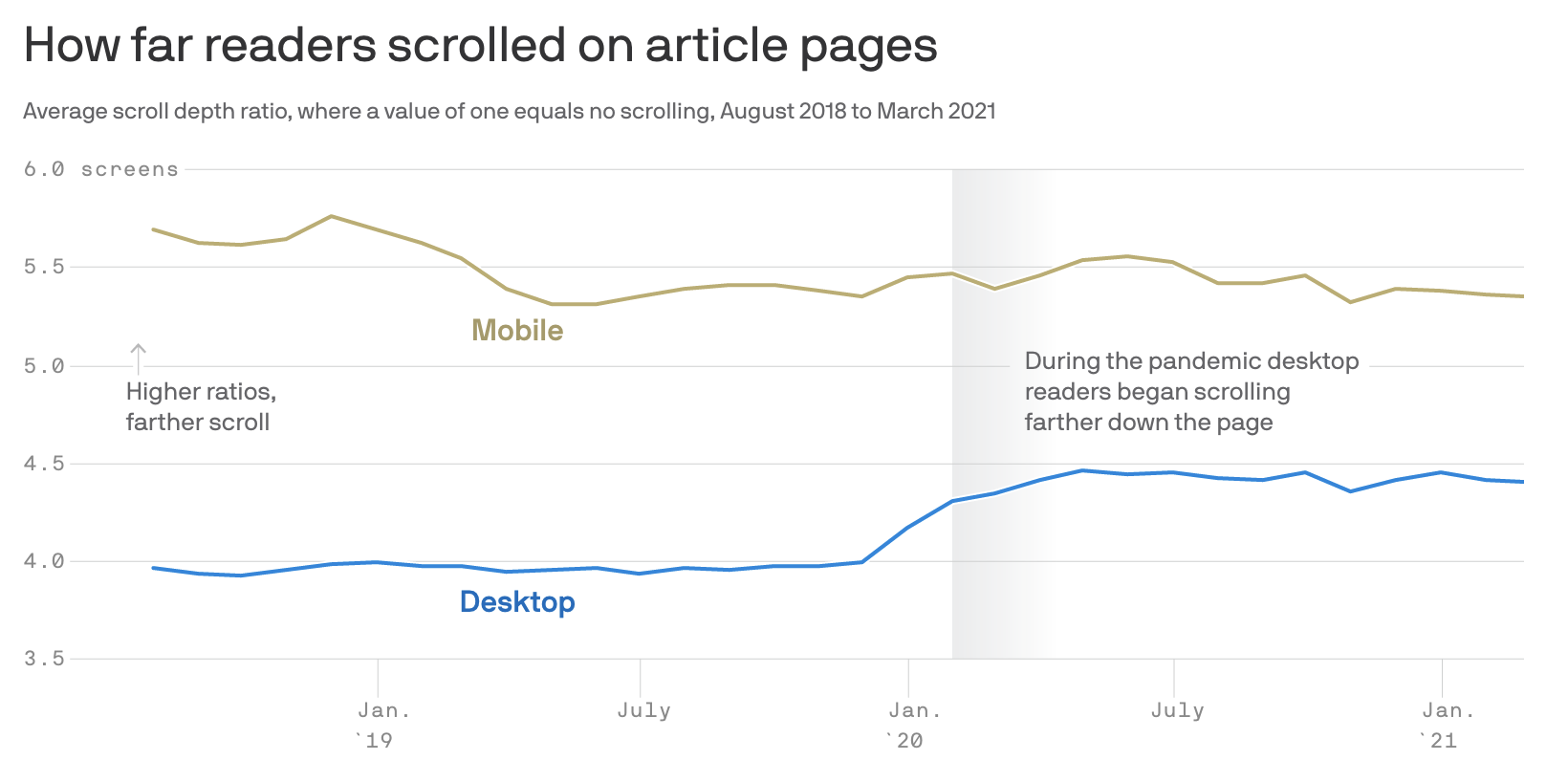Subscribe now and get the latest podcast releases delivered straight to your inbox.
TL;DR, desktop content consumption is up
- New data shows that, because COVID-19 forced millions of us to start working from home, mobile vs. desktop reading and scrolling habits have shifted... in the favor of desktop, where scrolling depth and content engagement is up substantially from pre-pandemic levels.
- Of course this isn't just about your behavior or my behavior – your ideal buyers are included in those numbers, a truth that should have broader implications for all of us.
- Although a responsive, mobile-prioritized approach to content and design is still a critical search ranking factor, you should keep in mind this news that the desktop isn't isn't as passé as you might have thought, as you develop your business websites and your content strategy.
Now let's dig deeper into the story
I wanted to share a picture of my work-from-home environment to kick-off this story about the change in all of our content consumption behaviors...

"HI, I AM HAM THE DOG, HOW ARE YOU?"
...and here's how it turned out.
Which, frankly, is much a more accurate portrayal of work-from-home life than the staged, utopian farce I was trying to snap. Sigh, in my home, "sit" is considered more of a suggestion rather than a must-be-followed command.
I'm sure many of you can relate to this reality
Yes, some of us are beginning to trickle back into the office (either full-time, part-time, or occasionally). But almost a year and a half ago, the line between work life and home life became much more blurry, didn't it?
🎓 IMPACT+ course: Creating memorable, money-making content for dummies
Eighteen months ago, I would intentionally leave my work laptop at work to give myself "a night off." Then the COVID-19 pandemic struck. Since then, I'm much more likely to be "doomscrolling" or sliding across the internet on my laptop rather than my phone at all hours, because everything is happening at home, right?
We're handling virtual sales calls with signs outside our home office doors for the kids to keep it down. We're hosting virtual events because we're still iffy on in-person events being totally safe. We're spending more time cruising educational content that answers our most pressing questions on our computers at home.
And so are your buyers.
And now we have the data to back it up.
Desktop scrolling and content engagement is up
Earlier this week, Axios shared exclusive data they received from Chartbeat about device-specific content engagement and scrolling behaviors:
In short, in the wake of the pandemic, website visitors (including yours) are now scrolling deeper into website pages and content on their desktop computers.
This news matters, according to Axios, because it illustrates how people prefer to engage more deeply with long-form content when we have the ability to experience it in a format that's more conducive to exploration.
🎓 IMPACT+ course: Self-selection and the touchless website buying experience
For example, I can't tell you how many times I've bounced off a long-form article on my mobile device because it's just harder to read on such a small screen for a long period of time without being distracted or being annoyed by CTAs, ads, and more. And, quite frankly, I feel this friction much less when I'm on my desktop computer.
Furthermore, according Axios reporting:
"Articles are encountered differently on desktop versus mobile. [Bonnie Ray, head of data science at Chartbeat] found the portion of article views from search with no scrolling has gone down significantly over time, but hasn't changed on social.
A higher percentage of search traffic versus social occurs on desktop, so 'it could be that articles we seek out via search are more relevant to us versus ones served up to us on social,' Ray says."
On top of that:
"In North America, the percentage of people who do not scroll "below the fold," on article pages has decreased significantly during the pandemic from 34% to 25% across both mobile and desktop."
Why this matters for your digital strategy
Back in 2015, Google's "Mobilegeddon" update – which prioritized websites in search rankings that displayed well on mobile, without a "mobile-only" version of their website – pushed many of us toward a mobile-first design mindset, wherein we start designing for the smallest screens first.
While this kind of device-agnostic approach to our business website design projects is important, I think some of us went a little too far toward an extreme "mobile at all costs" mindset, where we mentally demoted the desktop experience for our users, in terms of importance.
Also, by a show of hands, how many of you are still deathly afraid of putting content on your website pages "below the fold" because you think no one will see it?
Yeah, that's what I thought.
Well, my hope is that this data shows you a few things:
- Yes, the mobile experience is crazy important, but you need to focus on the experience you're creating with your content on desktops, as well. Especially since that's where more of your buyers are spending time with your content.
- Stop fearing what lives below the fold. You cannot create website experiences where the content real estate market above the fold is more cramped than the strip in Las Vegas.
- And, in the words of my favorite people at What's New in Publishing: "If readers are now sitting back at home and engaging at a deeper level with articles on their desktop, that in turn means the time spent on the site will be generating more revenue than if they’re skimming through a piece on a small screen on their commute."
And, most importantly, validate your design and content strategy decisions with data. Don't be moved to take action of any kind by "expert analysis and data" (that isn't your own) alone – including this article.
Your buyers may be different.
You may be the exception to the rule.
Or you may not see as much of a swing in behavioral shifts as others are.
So, in this case, I urge you to review your Google Analytics data to see what your percentage breakdown of mobile vs. desktop actually is, as well as whether or not it's changed as a result of the pandemic.
Free Assessment:


